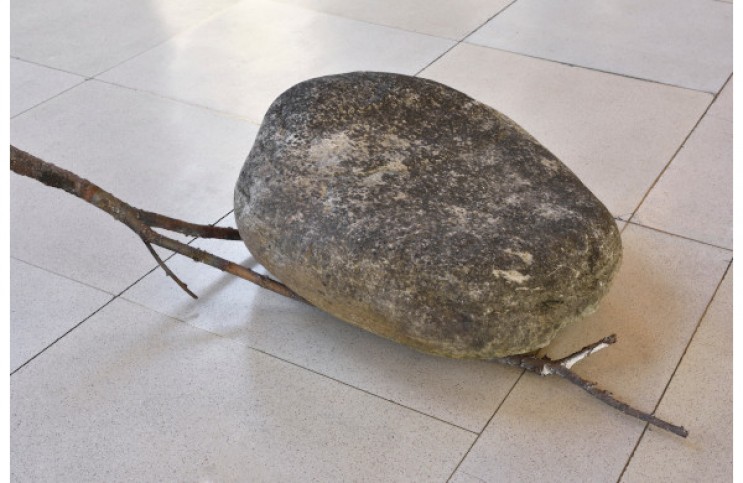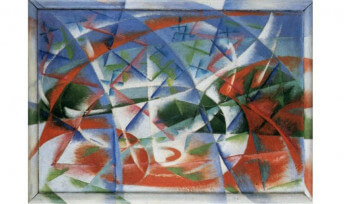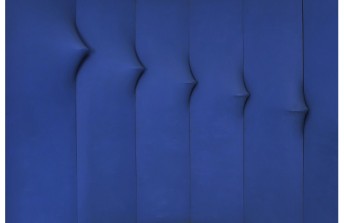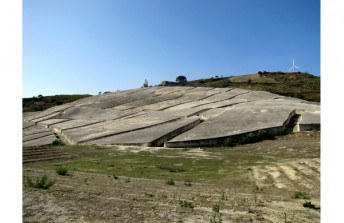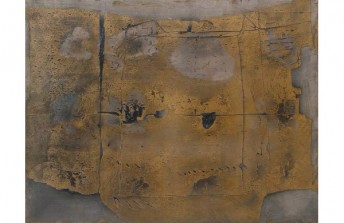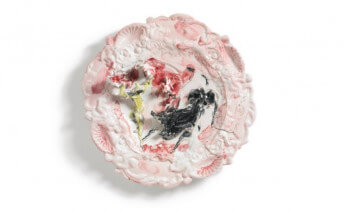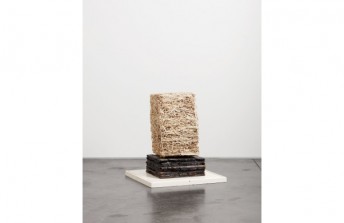Abstraction and Arte Povera Through The Spirit of Giuseppe Penone’s Lymph Matrix
Oct 22, 2019
Visitors to the Palais d’Iéna in Paris during the Foire Internationale d'Art Contemporain (FIAC) 2019 received a rare treat: the installation of Matrice di Linfa (Lymph Matrix), a 40-meter-long bisected pine tree sculpture Giuseppe Penone first presented in 2008. Upon first noticing the Matrice di Linfa in the grand hall of the palace, viewers may not have recognized it as a work of contemporary art. They may have thought a viking canoe was on display. Severed lengthwise, carved out in the middle, and its branches severed at 80 the centimeter mark, the felled tree indeed resembles an ancient conveyance, its stunted oars propelling it through mystic rivers. Looking closer, however, additional interventions become apparent. A vegetable resin simulating sap runs through the cavity like a stream, covering bodily imprints Penone made of his hands and feet. On the floor are sheets of leather. In an accompanying essay, Penone writes, “The trunk of an overturned pine loses some of its vegetal nature and suggests a different, animal kind of nature; The branches that, moving in the wind, have pushed the tree towards the light, now surround it like a sacrificial altar.” The work is idiosyncratic and hard to read—a perfect statement of the artistic philosophy Penone helped pioneer: Arte Povera, or Poor Art. A revolutionary aesthetic perspective first summarized by Germano Celant in 1967 in his manifesto “Notes for a Guerilla,” Arte Povera embraces humanization and nature. In his manifesto, Celant blasted the systematic dehumanization of art he saw being perpetrated in the United States, where self-appointed authorities like critics, curators, professors and dealers conspired with history to fabricate so-called art movements. “Over there a complex art,” he wrote, “over here a poor art, committed to the present. The goal is liberation...an abolition of all positions couched in terms of categories (either “pop” or “op” or “primary structures”) in favor of a focalization of gestures that add nothing to our refinements of perception, that don’t contrapose themselves as art to life, that don’t lead to the fracture and creation of two different planes of the ego and the world.”
Individuality Now
One of the enduring misunderstandings about Arte Povera is that the word Povera has something to do with cheapness or flimsiness in terms of the materials used in the work. In truth, nowhere in “Notes for a Guerilla” does Celant mention that Poor Art has to be made with materials that will not last. Quite the opposite, in fact. He suggests that Poor Art can be made using any means or materials the artist chooses. “The artist becomes a guerrilla fighter,” he says, “capable of choosing his places of battle.” This fallacy may be a generalization arising out of a misreading of the works of first generation Arte Povera artists like Pino Pascali, who used simple ingredients like dirt and water in his work; Piero Gilardi, who appropriated mundane, everyday objects like tools from a hardware store; Piero Manzoni, who made art from his own excrement; or Alberto Sacchi, who said, “I chose to use poor materials to prove that they could still be useful.”
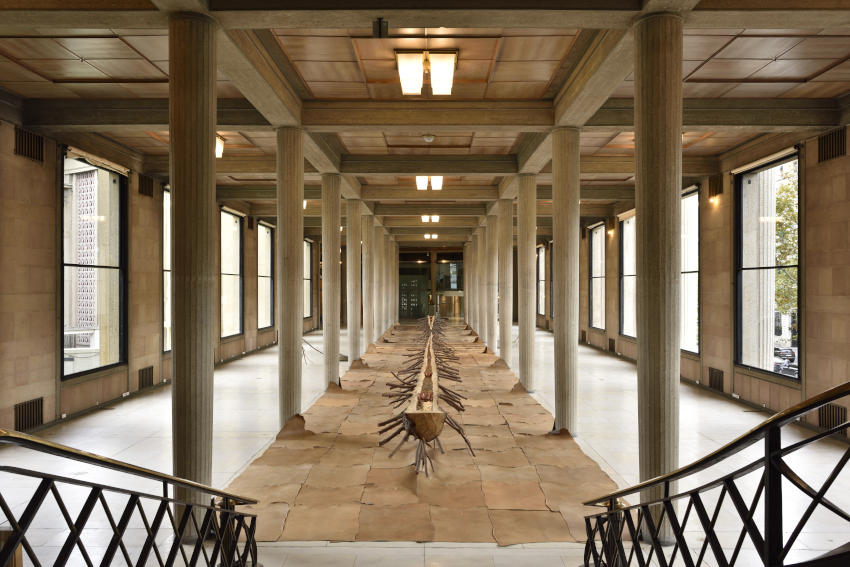
Giuseppe Penone, Matrice di Linfa, Palais d’Iéna, October 2019, Exhibition view. Giuseppe Penone, Matrice di linfa, 2008. Fir tree, resin, terracotta, leather, metal , 131 x 4500 x 212 cm. Photo credit: Rebecca Fanuele © Palais d’Iéna, architect Auguste Perret, UFSE, SAIF. Courtesy Archivio Penone and Marian Goodman Gallery, New York, Paris, London
The operative word that Sacchi used, however, was “choose.” Acting as though all Arte Povera artists made the same choice ignores the work of Gianni Piacentino, who used materials like Plexiglass, rubber, polyester, iron and copper; or Alighiero Boetti, who is most famous today for his maps. Boetti used everything from postage stamps to plastic pens in his work, but materiality was not his main concern. What mattered most was making personal statements, or self-evident, empirical statements, such as noting the obvious cultural diversity of the world. In fact, the only thing Celant said is essential to Arte Povera is that artists prioritize individuality. Gendered language aside, his manifesto exalts the self, stating “The man is the message. Freedom, in the visual arts, is an all-contaminating germ. The artist refuses all labels and finds identification only with himself.” Celant even muses that the term Poor Art could easily even be exchanged with the phrase Rich Art, thanks to “the enormous instrumental and informational possibilities” artistic liberation offers.
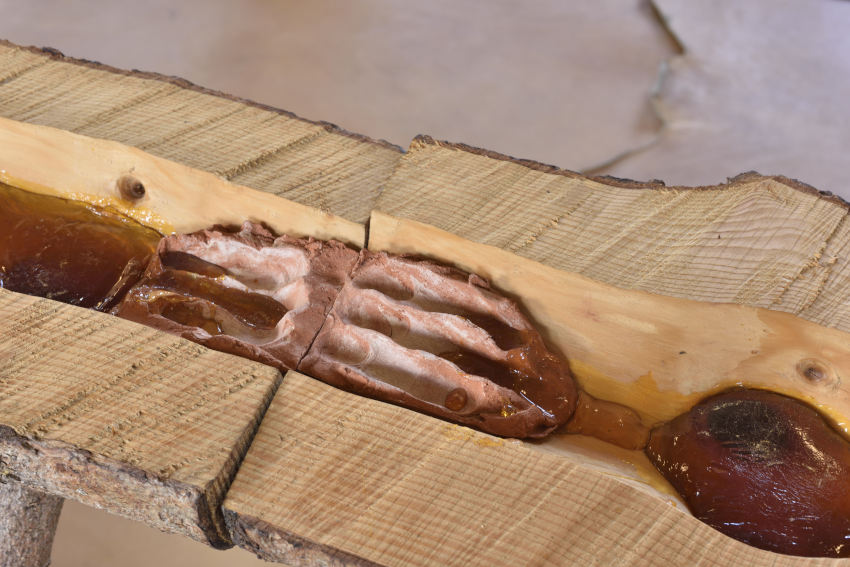
Giuseppe Penone, Matrice di linfa, 2008 (detail). Fir tree, resin, terracotta, leather, metal , 131 x 4500 x 212 cm. Photo credit: Rebecca Fanuele. Courtesy Archivio Penone and Marian Goodman Gallery, New York, Paris, London
Eradicate the Cliché
Another misunderstanding about Arte Povera is that it was a movement that began and ended in Italy in the mid 20th century. In truth, it has always existed and hopefully always will exist. Celant only put words to a reality that has always been part of the human condition: the internal battle between structured governance and leaderless freedom. In this respect, the Arte Povera spirit is evident in the oldest art known to us: the Paleolithic cave art of Northern Spain. We can see that this art was made with whatever materials were available, and that it seems to reflect humanity and nature. But we know nothing about the social structure of the artists who made it. Were they free? Were they prisoners? Were they part of a structured society? Were they voluntary members of a non-hierarchal clan? Their work forever resists fully being explained, except to say that it exists—a perfect Arte Povera statement.
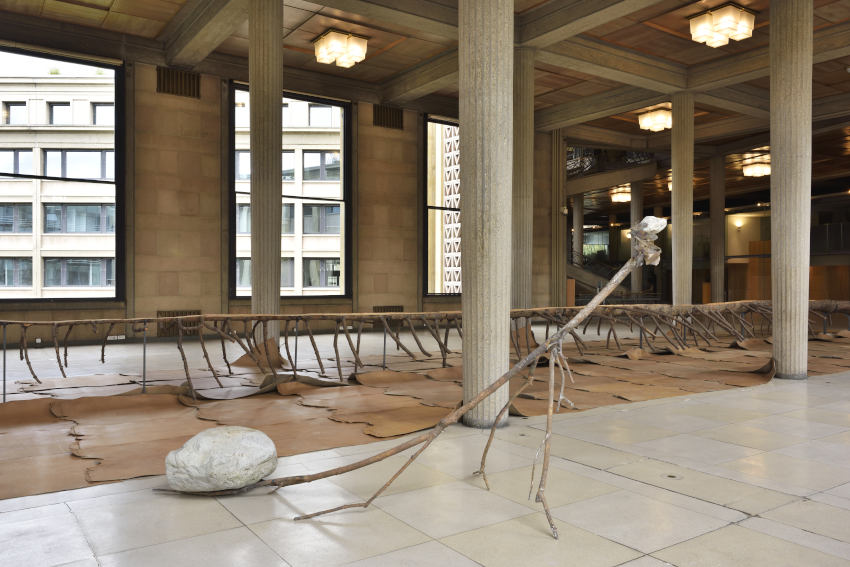
Giuseppe Penone, Pensieri di foglie, 2016. Bronze, river stones, 189 x 132 x 315 cm. Photo credit: Rebecca Fanuele © Palais d’Iéna, architect Auguste Perret, UFSE, SAIF. Courtesy Archivio Penone and Marian Goodman Gallery, New York, Paris, London
It could be said that that same spirit is also what spurred Marcel Duchamp to constantly question what the institutions of society consider art, and that it is what inspired the Gutai Group, Fluxus, the Nouveau Realists and the Zero Group towards their ambiguous discoveries. And it is still present in the practices of countless contemporary artists who make unclassifiable work, or who resist the pressure to repeat themselves. As Celant wrote in his manifesto, “This work is committed to the registration of ‘the irrepeatability of every instant.’” Is this commitment not at the heart of abstraction? By making definitive statements about what is categorically indefinite, every abstract artist to some degree helps us escape the “consistency of dogma” so we might set ourselves free. In their solitary ways, working towards the expression of the unknown and the manifestation of the previously unseen—hoping, perhaps in vain, not to copy what already is—these artists are the inheritors of one of the primary aspirations of Arte Povera: the eradication of the cliché.
Featured image: Giuseppe Penone - Pensieri di foglie, 2016, detail. Photo credit: Rebecca Fanuele © Palais d’Iéna, architect Auguste Perret, UFSE, SAIF. Courtesy Archivio Penone and Marian Goodman Gallery, New York, Paris, London.
All images used for illustrative purposes only
By Phillip Barcio
